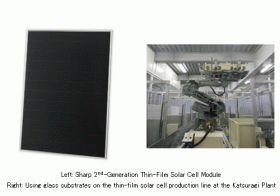Sharp Launches Mass Production of 2nd-Generation Thin-Film Solar Cells

Sharp Corporation has completed installation of a new 2nd-generation thin-film solar cell production line at its Katsuragi Plant (Katsuragi City, Nara Prefecture) using large-size glass substrates measuring 1,000 x 1,400 mm, equivalent to 2.7 times the area of conventional substrates (560 x 925 mm), and will begin volume production this October.
The addition of this new line expands production capacity for thin-film solar cells at the Katsuragi Plant to 160 MW annually.
Thin-film solar cells have a structure in which thin layers of silicon are deposited onto a glass substrate. This structure enables a dramatic reduction in the amount of silicon used to approximately one hundredth the amount used in conventional crystalline solar cells, and also enables simpler production processes that allow the glass substrates to be larger in size as well as lowering costs through manufacturing economies of scale.
In addition, thin-film solar cells offer superior temperature characteristics compared to crystalline solar cells in that their conversion efficiency tends not to decline at high temperatures. They generate ample amounts of electricity even in areas with high ambient air temperatures, and for this reason, demand for thin-film solar cells is skyrocketing for large-scale solar photovoltaic plants in hot climate regions like Southern Europe.
Photovoltaic modules fabricated using the 2nd-generation thin-film solar cells manufactured on this new production line feature an industry-leading 9% module conversion efficiency and high 128 W power output. Also, making the substrates larger and boosting power output means fewer modules are required for a given installation than before, making it possible to reduce the cost of installed systems. This can be expected to lower the cost of generating electricity.
These modules will first be shipped to large solar power generating plants in Europe where demand has been expanding rapidly.
Sharp has invested approximately 22 billion yen in this current production capacity increase, and is introducing this new production line capable of handling large glass substrates the same size as those to be used in a new thin-film solar cell plant slated to become operational in fiscal 2009 (at Sakai City, Osaka Prefecture; below, the “new plant”).
Sharp’s aim is to develop production technologies and accumulate know-how based on this production line and establish a production system at the new plant early on for thin-film solar cells that will achieve a module conversion efficiency of 10%, and lead to their subsequent development around the world.
Sharp will invest approximately 72 billion yen in the first phase of development at the new plant to establish a production system with an annual capacity of 480 MW.
Provided by Sharp





















